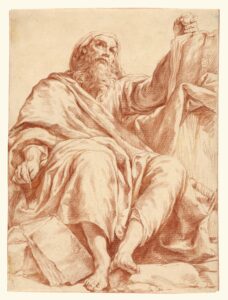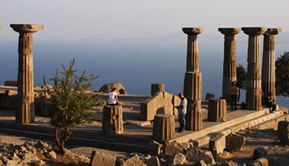Curious Letter-Collectors
Roy Gibson explores why collections of letters from the Greek world are so very different from those in Rome

A collection of letters between Seneca and Paul, represented here by Giuseppe Maria Crespi, 1720–30, in a Roman toga while he writes his Epistles, was forged around the fourth century (J. Paul Getty Museum; Image Courtesy of the Getty Open Content Programme)
Where Greece led, Rome followed. Epic, tragedy, comedy, history, philosophy, epigram, the novel. Homer inspires Ennius and Virgil; Euripides influences the tragedies of Rome from the Middle Republic to Seneca; Menander begets Terence; Thucydides is an exemplar for Sallust; Plato’s dialogues are a model for Cicero. The Romans invented some of their own stuff, of course, mostly rather low down in the hierarchy of genres: love elegy, satire. Not that literary Greeks of the early Empire cared, since they were too busy developing the new prose genres we find in Plutarch, Lucian and Aelian. Influence tended to flow in one direction only.
There is one genre in which the usual rules do not apply. Both Greeks and Romans wrote letters to fellow countrymen almost as soon as their languages had alphabets, and both began preserving sets of letters by famous figures at more or less the moment they realized they had literary classics worth collecting. The letters of Isocrates (436–338 BC) and Cicero (106–43 BC) were among the first to be circulated beyond their original intended addressees at Athens and Rome. Despite the 300-year start possessed by Greece, and for all the literary prestige of the Hellenic Mediterranean, Rome somehow failed to follow the example of the Greeks when it came to preserving (and inventing) collections of letters. The two literary cultures developed apart in ways that are sometimes surprising and even puzzling.
Around 31 Greek letter collections survive complete today, between Isocrates in the early fourth century BC and Synesius in the late fourth century AD. The Romans register about 18 extant collections between Cicero in the late first century BC. and Synesius’ contemporary Augustine in the late fourth century. It is of course something of a scandal that so many letters and letter collections survive at all, given that as little as one or two percent of classical Greek and Latin literature still exists today in terms of simple quantity. Just under 50 surviving letter collections is not a small size of sample for any genre. Roughly 30 Greek tragedies and about ten Latin tragedies survive complete down to late antiquity, and there are perhaps fewer than 15 surviving multi-book mythological epics in the same period – a few more if we include outliers such as Lucretius. Why so many letter collections?
Literary prestige and literary popularity were synonymous in antiquity, as Reviel Netz has made clear in his book Scale, Space and Canon in Ancient Literary Culture (2020). To be well-esteemed was also to be widely read: there are no ancient equivalents of the poet who retains kudos while being read by a mere handful of readers. (Callimachus may tell us he was a coterie poet, but in reality he was vastly popular). It was prestige that determined the survival of literary texts. Therein lies the clue: most of the surviving letter collections, both Greek and Roman, are attached to the biggest literary names of antiquity. Ancient readers generally collected illustrious names for their literary papyrus rolls and manuscripts (magpie medieval readers put their collections together on different principles), and went to some lengths to collect all the works of the most prestigious names. Hence the survival of Plato and Aristotle in bulk, and of the letter collections that were attached to their names.
The roll call of the earliest surviving Greek letter collections proves the point about literary prestige: Isocrates, Demosthenes, Anacharsis, Plato, Aristotle, Hippocrates, Diogenes, M. Brutus, Heraclitus, Chion, Themistocles, Socrates, Crates, Apollonius of Tyana, Euripides. Importantly, these are all later forgeries by admiring disciples and readers – apart from Isocrates and Demosthenes; my presentation of the collections in the most likely chronological order of their composition underlines the point (Euripides lived long before the rest). The letter collections of the New Testament belong somewhere in the middle of this list, perhaps between Chion and Themistocles. This was the era of forgery in the eastern Mediterranean, and up to 14 out of 21 epistles in the New Testament can reasonably be described as either forgeries or falsely ascribed to their named authors.
But it was not the era of epistolary forgery in the western Mediterranean. This is the first major difference between Greek and Roman letter collections. Stray letters might be forged here and there, of course; two appear to have made their way into the correspondence between Cicero and Marcus Brutus. A further pair, attested in a single manuscript, purport to preserve the correspondence between Caesar and Sallust. But, unlike the Greeks, Romans of the classical era had little interest in forging an entire collection for attribution to famous figures. Of the 18 Latin letter collections to survive from before the end of the fourth century, only two fit the mould of fictional letter collections established by Greeks: Ovid’s Heroides and the letters of Seneca and Paul.
In truth the Heroides – fictional love letters sent largely by Greek mythological heroines to men from whom they are separated – are an uncomfortable fit (as we will see in a moment). Rather closer in spirit to the Greek collections are the 14 short letters exchanged between Seneca and Paul – probably forged at some point in the fourth century. Devoid of significant doctrinal and philosophical content, the letters consist largely of exchange pleasantries (like the correspondence of their late-fourth century contemporary, the senator Symmachus). However, Seneca’s frequently expressed interest in Paul and his writings (letters 1, 3, 7, 13) culminates in letter 14 and the suggestion that Seneca has converted to Christianity. A useful outcome for late antique Christians in search of classical prestige for their newly triumphant faith.
It is hardly coincidental that these two fictional Roman collections feature Greek correspondents in the shape of Paul and the heroines of Greek myth. Presumably this is a nod to the Greek origins of such collections. But why were there no invented collections for Ennius and M. Fulvius Nobilior, for Terence and his cultivated circle, or for Virgil and Maecenas? Somehow, the brilliant forgeries of the Greeks never took a hold in Roman minds. Equally puzzling is the penchant among Romans for letter collections written in verse, and the complete absence of equivalents further east.
The Roman tradition begins with Horace’s philosophical verse epistles (published not long after the Odes), and continues with Ovid, who adds to the Heroides his Letters from Pontus: a late-life collection reflecting on the miseries of exile on the western shore of the Black Sea. Later Roman letter collections often include verse within their confines (Pliny comes to mind), but it would take until the late fourth century for a full-scale re-awakening of the tradition. Ausonius of Bordeaux wrote several collections of verse in Latin, and engaged in a lengthy poetic dialogue with his old pupil, Paulinus of Nola.
Meanwhile in the eastern Mediterranean? Nothing. Again, the reason for the divergence is unclear; but it is perhaps related to another development that divides east and west. The Greeks of the Hellenistic era invented the book unit as a way of dividing up or gathering together their classical and archaic texts. The book units had no standard size and might be very large (such as those used to articulate Herodotus and Thucydides) or rather small (such as those used to articulate the Iliad or above all the Odyssey). Contemporaries such as Meleager experimented with producing carefully constructed poetry books of their own. The fashion caught on like a fire in the poetry of Augustan Rome, from the Eclogues of Virgil to Ovid’s Letters from Pontus. In the process, the fire migrated from poetry collections to letter collections, and the compilers of the letter collections of Cicero (who were all working in the post-Augustan era) began to produce well-wrought books of letters of around the length that the Augustan poets had produced. In time, both Seneca and Pliny followed suit.
By contrast, among Greek letter collections, the book unit is almost entirely absent: from Isocrates to Synesius, book units are found in only two collections, those of Alciphron (third century) and Libanius (fourth century). Somehow, in Roman minds, there was a close connection between the poetic tradition begun by the Augustans and their epistolographic tradition. No wonder the Romans were the first to write book-length collections of letters in verse. The Greek tradition, on the other hand, is epitomized by the New Testament letters – despite the cultural irrelevance of the latter in the pre- AD 200 era. Greek readers were happy with a long series of letters undivided by books.
Finally, one difference that would have surprised taciturn Romans about their loquacious Greek counterparts. Greek letters are generally much shorter than their Roman equivalents. There are exceptions, but letters in Greek collections rarely rise above 40-50 lines in length. That pattern does not change even in late antiquity, when Greek Christian letter-writers had the model of the rather lengthy Pauline letters of the New Testament to emulate. Long letters entered the Roman tradition rather early with Seneca (whose philosophical letters average over 110 lines per letter) and stayed in the even longer letters of Ambrose, Jerome and Augustine. Letter-writing Romans clearly didn’t get the memo from Greek epistolary theorists about the importance of brevity.









